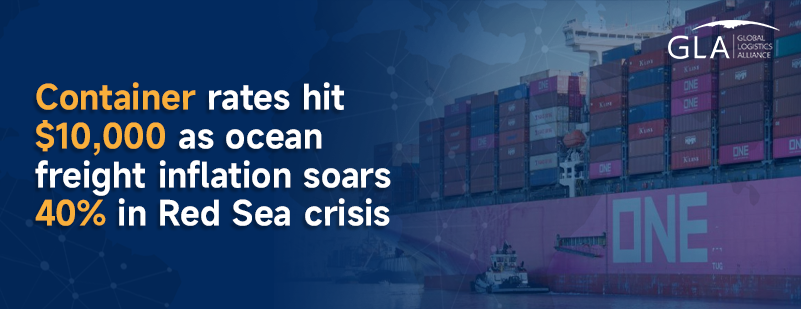Welcome to GLA! Leading the global logistics alliance.


Your location:Home > News > Container Rates Hit $10,000 as Ocean Freight Inflation Soars 40% in Red Sea Crisis
Time:2024-02-05 Publisher:Kevin Num:5921

In a sudden turn of events, the global supply chain is facing a severe crisis as 158 vessels, carrying approximately $105 billion in ocean freight, are being diverted away from the Red Sea due to the escalating risk of Houthi attacks. This redirection, coupled with the continuing aftermath of the COVID-19 pandemic, has led to a dramatic 40% increase in ocean freight rates, with container prices reaching an alarming $10,000. This has triggered concerns among logistics executives, who fear potential "opportunistic" price gouging.
The impact of these diversions is immediate and far-reaching, affecting various industries and prompting companies like IKEA to anticipate delays in product availability. CNBC reports that the global logistics community is now grappling with a two-fold challenge – rising ocean and air freight prices and stranded cargo, both posing significant threats to the fragile state of the global supply chain.
The surge in ocean freight prices was rapid, with logistics managers quoted an astounding $10,000 per 40-foot container from Shanghai to the U.K., a substantial increase from the previous week's rates of $1,900 for a 20-foot container and $2,400 for a 40-foot container. Alan Baer, CEO of OL USA, emphasises the need for clarity on these massive rate hikes as importers, exporters, and government regulators seek to understand the underlying drivers.
As of Thursday morning, 158 vessels, rerouted from the Red Sea, are carrying over 2.1 million cargo containers, holding an estimated value of $105 billion. With no immediate end in sight to the Houthi attacks, major companies like IKEA are already facing supply chain disruptions. IKEA states that it is actively exploring alternative freight options to mitigate delays and ensure product availability.
Danone, on the other hand, disputes reports of short-term supply chain impacts, stating that there has been no significant disruption. The situation remains fluid, and logistics managers are actively working on solutions for stranded cargo in Europe and the Middle East, considering alternatives such as air freight and exploring new trade routes.
The severity of the crisis depends on the duration of the vessel rerouting. Logistics CEOs warn that if the timeline exceeds one month, inflationary pressures will be felt throughout the supply chain and eventually impact consumers. The sudden spike in ocean freight prices, coupled with the uncertainty of the situation, has raised questions about transparency in cost increases by ocean carriers, especially as they no longer incur the Suez Canal toll.
The crisis is also impacting air freight, with European shippers looking to air transport due to longer transit times caused by the Red Sea diversions. As ocean carriers like Maersk and CMA CGM work to manage their container destiny and respond to crises swiftly, the global shipping community is closely monitoring the situation, aware of the potential long-term implications on the supply chain and inflationary pressures.
Prev:Risk of Cyberattacks on Supply Chain ManagementNext:The Power of Collaboration: Exploring the Benefits of Joining a Logistics Alliance Network
Recommended Membership
Latest News